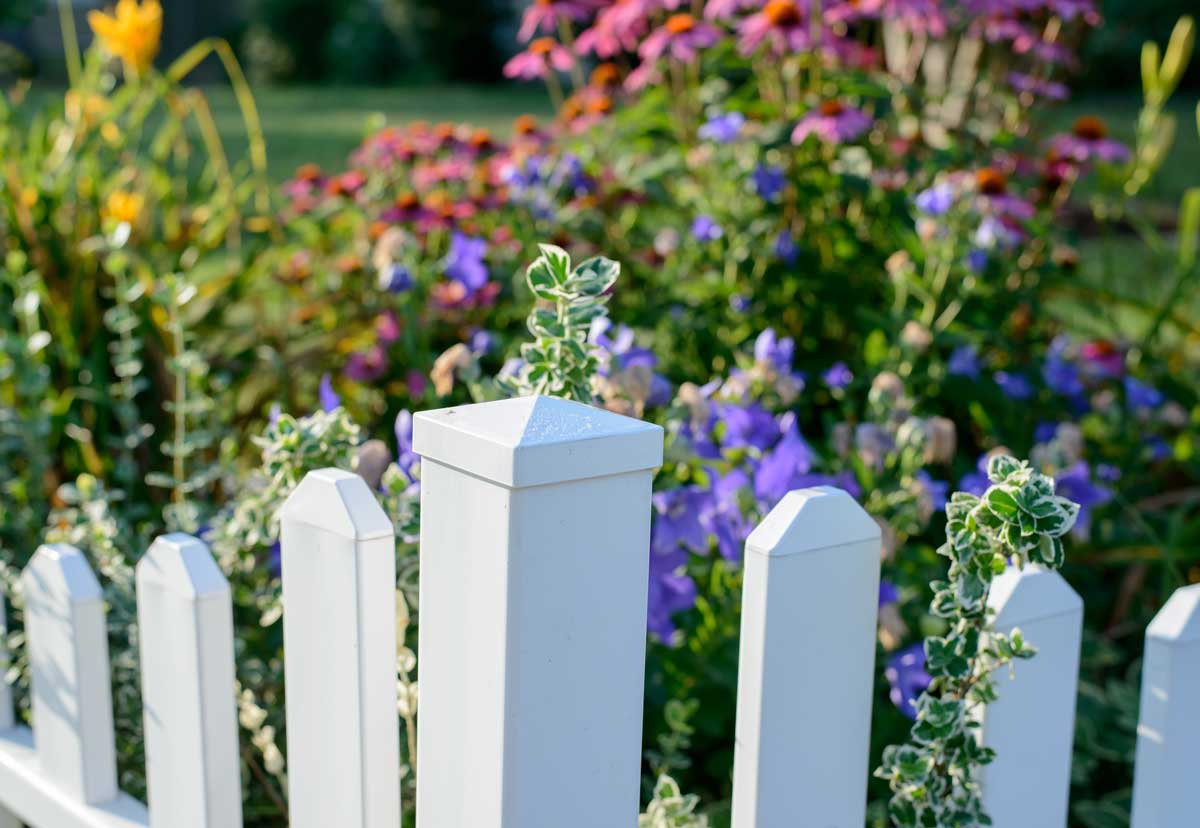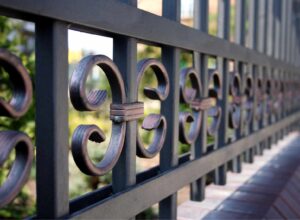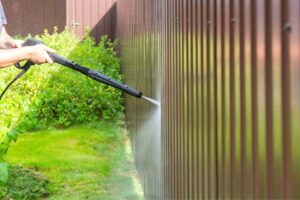The Ultimate Fence Height Guide
Wondering how tall your fence should be? There’s a lot to consider as you start the fence installation process, and fence height is one of these crucial details. Not only should your fence’s height suit your own preferences, but it also needs to serve a practical function and adhere to local regulations.
In short, there’s no universal standard for fence height. How tall you build your fence depends on the fence. In the guide below, we offer some of the typical fence height ranges we see based on fence type.
Standard Fence Height By Fence Type
While the “normal” height of a fence ranges from 4 to 6 feet, fence height can vary significantly and depends on multiple factors:
- The purpose of the fence
- Where the fence is located on your property
- The fence material
- The homeowner’s preferences
- HOA or local regulations
Here’s a breakdown on fence heights for the most common fences based on the factors above:
Front Yard Fence
Average Height: 3–4 feet
While a front yard fence is known for adding curb appeal, it can also serve a security purpose, helping to keep unwanted people and animals away from your property. Picket fences (which feature a gap between each post) are the most popular style for a front yard fence, and many homeowners opt for wood or vinyl for their durability and aesthetic appeal. Front yard fences are typically not tall — averaging about 3–4 feet — but check your local fence regulations for height restrictions.
Privacy Fence
Average Height: 6–8 feet
A privacy fence is usually a solid, tall fence designed to obstruct views of your property. For this reason, privacy fences are especially popular for backyards. The most sought-after materials for privacy fences include vinyl, wood, or chain link. Most homeowners opt for a fence height of 6–8 feet to ensure neighbors can’t see over the fence, but check with local regulations before you settle on the dimensions.
Security Fence
Average Height: 6–8 feet
A durable 6–8-foot privacy fence will act as a barrier against unwanted entry in many cases. However, if you want the extra protection, a security fence made out of metal, such as aluminum or wrought iron, is worth considering, as it will be difficult to cut through. On the other hand, metal fences offer high visibility of your property to potential intruders. Also, not all zoning areas permit them, so do your research on the front end. Whatever material you choose, 6–8 feet is the typical height range for a security fence.
Vinyl Fence
Average Height: 4–6 feet
A vinyl fence is one of the most attractive fence options available to homeowners. It’s also highly durable and resistant to pests and the elements, minimizing the need for repairs. This makes vinyl fences popular choices for all of the above — front yards, back yards, privacy fences, and security fences. Most vinyl picket fences — typically used for front yards — are around 4 feet in height, and solid vinyl fences tend to measure 6 feet tall.
Wood Fence
Average Height: 4–6 feet
Wood is the most common fencing material thanks to its versatility. Wood picket fences add curb appeal to front yards, and solid wood fences are useful as both privacy and security fences. As with vinyl, the average height of a wood fence will depend on the type of fence and where it appears on the property. In most cases, this will be 4–6 feet, although some homeowners opt for a height of up to 8 feet where privacy is the primary goal.
Chain Link Fence
Average Height: 3–4 feet
Due to its longevity and affordable price tag, chain link is one of the most common fence materials. And when combined with a screen to limit visibility, a chain link fence can also offer privacy. As chain link isn’t considered to be as aesthetically pleasing as wood or vinyl, some homeowners associations or local regulations don’t allow them. In cases where they’re permitted, there may be height restrictions to be aware of. The average chain link fence height is usually 3–4 feet.

Garden Fence
Average Height: 3–4 feet
Do you keep a garden? A fence can help your plot flourish by protecting it from wind, excessive sunlight, and unwanted animals. Most garden fences are around 3–4 feet tall, but heights will vary based on the animals you want to keep out. For optimum protection, install a solid fence rather than a picket fence, as pests can crawl between picket gaps.
Deer Fence
Average Height: 10 feet
Deer can pose a serious threat to your property, as they’re known to destroy lawns by eating the vegetation and to spread ticks and fleas. If you live in a deer-populated area, a deer fence can effectively prevent them from encroaching on your yard. Considering how high deer can jump, your fence will need to be a minimum of 10 feet tall to keep them out.
Dog Fence
Average Height: 4–6 feet
Trying to keep your dog in, or the neighbors’ dogs out? The standard fence height for dogs is about 4–6 feet, but this can vary based on the type of dog. And remember, a fence doesn’t guarantee that Fido will stay put. Some dogs can tunnel under fence panels to dig themselves free, but there are some ways to stop dogs from digging.
Pool Fence
Average Height: 4–6 feet
Whatever your reason for installing a pool fence — whether for privacy, safety, or to get a discount on your homeowners insurance — it’s a smart move for homeowners. In fact, depending on where you live, it may be the law. Most pool fences, which are usually made of aluminum, tend to be 4–6 feet in height — high enough to keep small children and animals out. Be sure to check your local pool fence regulations before you move forward with installation. For more pool safety guidelines, consult the U.S. Consumer Product Safety Commission.
How Do I Make My Fence Taller for Privacy?
If your current fence is not tall enough to suit your needs, you can extend its height with DIY or custom fence toppers such as these options below:
- Trellis topper: Most trellises are about 1–2 feet tall, so make sure the fence still adheres to local height parameters before you make this addition.
- “Living fence”: A living fence is a vertical screen that you can secure to the fence posts and grow climbing plants on. This accessory not only increases fence height, but it also offers shade, privacy, and a serene ambiance.
- Metal decorative topper: These toppers are known for adding a touch of elegance to a fence and are usually custom-made.
- Horizontal fence topper: Topping your fence with horizontal wood paneling is a nice way to hop on this stylish, up-and-coming fence trend without having to spend the money on a 100-percent horizontal fence.
How to Measure Fence Height
It’s vital to measure fence height accurately in order to make sure your fence adheres to local ordinances and HOA parameters. Use a tape measure, starting from the ground and measuring to the top of the fence. Make sure to include any ornamental accents, such as lattices or post caps, in this measurement as well.
If you don’t have a tape measure accessible, simply use a board that measures as long as your desired fence height — whether that’s 3 feet or 8 feet — as your reference point.
Checking Local Fence Regulations
One of the most vital first steps as you begin the installation process is to check your city or county fence regulations. Otherwise, if your new fence isn’t up to standards, you run the risk of receiving a major fine, if not an order to replace the fence altogether.
Here are a few ordinances to account for if you’re planning to construct a fence within a residential community:
- The city must approve of the fence design and placement before you start installation.
- The fence can’t restrict access to local utilities, public spaces, and city or town limits.
- The neighbors on either side must agree on the fence placement, and it cannot infringe on the boundary line between their properties.
- The HOA, if you belong to one, must issue legal permission to build a fence. An HOA can dictate the style, color, and material of your fence as well.
For information on fence height parameters in your area, contact the building codes enforcement division for your city or county, whichever applies.
Build Your Dream Fence with Help from the Pros
Whatever kind of fence you opt for, hiring a professional contractor will ensure not just your fence height but the entire fence is up to standards.
At Top Rail Fence, we offer the highest quality fence products installed by trained professionals. When you choose our premium fencing materials and installation services, you’re making an investment that will ensure maximum privacy, security, and peace of mind for years to come.
Need some help with your fencing project? Contact our team for a free quote.


